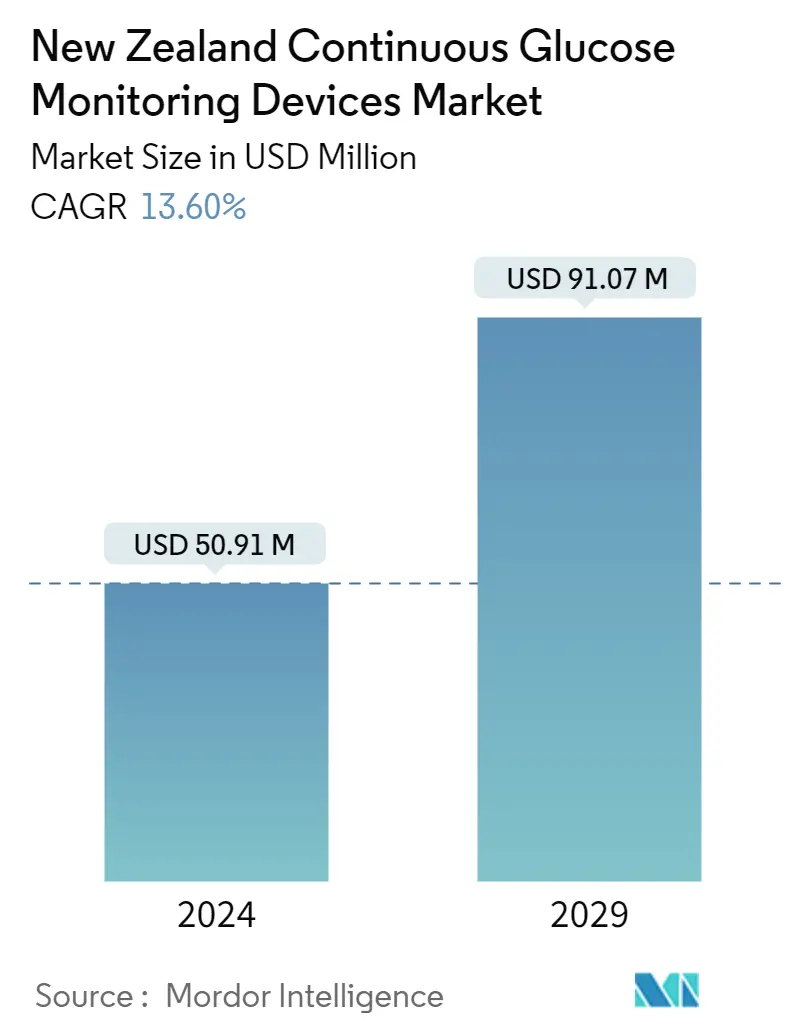Market Size of New Zealand Continuous Glucose Monitoring Devices Industry

| Study Period | 2018- 2029 |
| Base Year For Estimation | 2023 |
| Forecast Data Period | 2024 - 2029 |
| Historical Data Period | 2018 - 2022 |
| Market Size (2024) | USD 50.91 Million |
| Market Size (2029) | USD 91.07 Million |
| CAGR (2024 - 2029) | 13.60 % |
Major Players
*Disclaimer: Major Players sorted in no particular order |
New Zealand Continuous Glucose Monitoring Devices Market Analysis
The New Zealand Continuous Glucose Monitoring Devices Market size is estimated at USD 50.91 million in 2024, and is expected to reach USD 91.07 million by 2029, growing at a CAGR of 13.60% during the forecast period (2024-2029).
The COVID-19 pandemic highlighted that substantially greater attention had to be given to diabetes to avoid unnecessary and inequitable outcomes from the infection. All necessary steps were taken and maintained to protect this high-risk group through nationwide public health measures to prevent transmission, ensuring vaccination has been given and undertaking workplace risk assessments. Notably, the rates of diabetes are higher among Maori, Pacific, and South Asians compared with New Zealand Europeans, particularly those living in deprived situations. These groups were especially vulnerable to the far-reaching impacts of the COVID-19 crisis, as they were disproportionately exposed to risk, potentially exacerbated by the sudden loss of jobs and income and reduced access to usual social support and healthcare.
Mediray (Distributor Company for Freestyle Libre Products) was classed as an essential service and continued to provide FreeStyle Libre systems as usual. The Mediray technical support line remained open for call-in and pick-up options. Such factors impacted market growth positively during the pandemic.
In 2021, the Ministry of Health Virtual Diabetes Register estimated that more than 290,000 people were living with diabetes. The Pacific population had the highest estimated rate of diabetes, followed by the Indian population and the Māori population in New Zealand. The European or other populations had the lowest estimated rate of diabetes. Blood glucose level testing is a crucial technology for Diabetes because it facilitates knowledge of how different foods, medications, and activities affect a patient's diabetes and how much insulin is needed, and when for effective diabetes management. Generally, glucose testing was done with finger-pricking kits that measure levels via small blood samples. Currently, automated glucose monitoring systems are being used.
Continuous Glucose Monitoring Devices are automated glucose monitoring systems that consist of a small device worn on the body (typically the abdomen or arm) and held on by an adhesive patch. The sensor part of the device has a cannula that is inserted into the top layer of skin and uses samples of interstitial fluid to check glucose levels. Sensors are connected to a transmitter that can send data wirelessly to a dedicated mobile receiving device or smartphone. The usage of CGMs for people with Diabetes and their caregivers and communities is beneficial for managing their blood glucose and insulin levels to maintain their health outcomes.
CGM makes it significantly easier to manage blood glucose levels by decreasing interruptions, allowing for better sleep and improving the mental health of patients or caregivers by reducing the overall mental load of managing diabetes, thereby enhancing the market prospects in the years to come.
New Zealand Continuous Glucose Monitoring Devices Industry Segmentation
CGM, as a wearable sensor, automatically detects and measures blood glucose levels around the clock. Data is then sent from the sensor to a receiver or smart device using a transmitter that is placed above the skin. Patients receive alerts from the transmitter or monitor their current glucose level and trends wirelessly, and it notifies patients when it’s time to replace the sensor. The New Zealand Continuous Glucose Monitoring Devices Market is segmented into Components (Sensors and Durables) and by Provinces. The report offers the value (in USD) and volume (in Units) for the above segments.
| By Component | |
| Sensors | |
| Durables (Receivers and Transmitters) |
| By Provinces (Quantitative Analysis) | |
| Auckland | |
| New Plymouth | |
| Wellington | |
| Nelson | |
| Other Provinces |
New Zealand Continuous Glucose Monitoring Devices Market Size Summary
The New Zealand Continuous Glucose Monitoring (CGM) Devices Market is poised for significant growth, driven by the increasing prevalence of diabetes and the rising awareness of diabetic care. The market is characterized by the adoption of automated glucose monitoring systems, which offer substantial benefits in managing blood glucose and insulin levels. These devices, typically worn on the body, utilize sensors to provide real-time glucose readings, enhancing the quality of life for individuals with diabetes by reducing the cognitive load associated with traditional monitoring methods. The market's expansion is further supported by the availability of advanced CGM systems, such as Freestyle Libre, Medtronic, and Dexcom, which have gained traction due to their ease of use and effectiveness in maintaining health outcomes.
The market landscape is highly consolidated, with major players like Abbott, Dexcom, and Medtronic leading the charge through continuous innovation and strategic growth initiatives. The introduction of new products, such as Abbott's next-generation FreeStyle Libre 2, underscores the commitment of these companies to enhance diabetes management solutions. The COVID-19 pandemic underscored the importance of diabetes care, prompting essential services to remain operational and ensuring continued access to CGM devices. As the prevalence of diabetes continues to rise, particularly among vulnerable populations, the demand for CGM devices is expected to grow, offering promising prospects for market participants over the forecast period.
New Zealand Continuous Glucose Monitoring Devices Market Size - Table of Contents
-
1. MARKET DYNAMICS
-
1.1 Market Overview
-
1.2 Market Drivers
-
1.2.1 Rapidly Increasing Incidence and Prevalence of Diabetes
-
1.2.2 Technological Advancements in the Market
-
-
1.3 Market Restraints
-
1.3.1 Monopolized Supply Chain and High Cost of Devices
-
-
1.4 Industry Attractiveness - Porter Five Forces
-
1.4.1 Bargaining Power of Suppliers
-
1.4.2 Bargaining Power of Consumers
-
1.4.3 Threat of New Entrants
-
1.4.4 Threat of Substitute Products and Services
-
1.4.5 Intensity of Competitive Rivalry
-
-
1.5 Analysis of CGM Device Distribution Channels
-
1.6 Analysis of CGM Device Prescribers
-
-
2. MARKET SEGMENTATION
-
2.1 By Component
-
2.1.1 Sensors
-
2.1.2 Durables (Receivers and Transmitters)
-
-
2.2 By Provinces (Quantitative Analysis)
-
2.2.1 Auckland
-
2.2.2 New Plymouth
-
2.2.3 Wellington
-
2.2.4 Nelson
-
2.2.5 Other Provinces
-
-
New Zealand Continuous Glucose Monitoring Devices Market Size FAQs
How big is the New Zealand Continuous Glucose Monitoring Devices Market?
The New Zealand Continuous Glucose Monitoring Devices Market size is expected to reach USD 50.91 million in 2024 and grow at a CAGR of 13.60% to reach USD 91.07 million by 2029.
What is the current New Zealand Continuous Glucose Monitoring Devices Market size?
In 2024, the New Zealand Continuous Glucose Monitoring Devices Market size is expected to reach USD 50.91 million.

